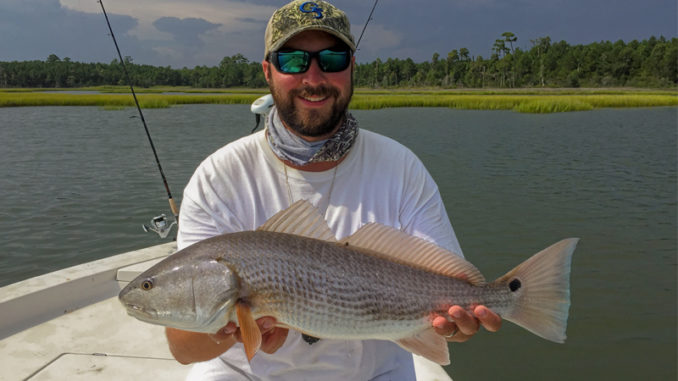
Ride the tides for exciting inshore action as August arrives in Bogue Inlet area
Red drum don’t react to August’s steamy heat by swimming through inlets to reach the ocean’s deeper, cooler waters.
Instead, back in marshes behind barrier island beaches, they seek creek channels during low ebbs of the tide, then swim back into mud flats covered by eel grass, cord grass, glass wort, sea lavender, bulrush and sawgrass during mid- to high tides.
Why? Food.
If your fishing needs an electric jolt, try fly-rod casting a crab fly in front of a “tailing” red in flooded grass, its nose on the bottom and rudder exposed as it grubs for tiny, black oyster crabs.
“The good thing about red drum fishing in August here is you focus on early and late high tides when it’s cooler,” said David Towler of Towler Time Charters, who fishes the area around North Carolina’s Bogue Inlet, including Swansboro’s waters.
Towler (910-554-4742) doesn’t get many requests to show the ropes to fly anglers, but plenty like catching reds with artificial lures or live baits.
Don’t shy away from big baits
“Bait, especially finger mullets, push up into the grass at rising tides and get pulled out when it falls,” said Towler. “It’s what reds look for. I look for (schools) at marsh edges that are good casting targets. The good news is, by August, baits have got pretty big, too, so I use 5- to 12-inch mullets.”
Bigger reds and the occasional flounder or spotted seatrout will also blast his clients’ baits.
“Early morning is when you get topwater bites from redfish,” Towler said. “I use a Top Dog or She Dog, silver with white bottom, the (MR 18), or the 808 with orange bottom/gold sides.
“If the water’s clear, I stick with natural colors. If we have stained water in the river, the She Dog’s got a little higher-pitched rattle. In dirty water, I like a full-size, 5- to 5 1/2-inch model. I try to match the sizes to the size of finger mullets and the conditions.”
Popping corks work well with live bait
Towler will fish popping corks along marsh edges, but only with live mullet, never artificial lures.
“If I’m fishing a clear bottom, I like jigheads and soft-plastic swimbaits or twitch baits,” he said.
When water is at mid levels, he searches for skinny creeks in the marsh grass that also have oyster rocks.
“That’s when I use a bass angler’s weighted hook,” Towler said. “I like the slow fall you get with a weighed worm hook (and a twitch bait).”
At low tide, he’ll find any deep water with current and cast a soft-plastic lure with a 1/3- to ¾-ounce weight, hopping it across the bottom, always throwing up current and retrieving his lure with the flow.
Towler prefers 7-foot medium-action rods mated with 2500 to 3000 series spinning reels spooled with 15-pound braid and 2-foot leaders of 25-pound fluorocarbon.
“I don’t use braid at oyster rocks,” he said. “Braid tangles and will wrap up in coon oysters, and oyster shells will cut it. Heavier monofilament or fluorocarbon works better around oysters.”
Towler said a typical 3- to 4-hour morning trip in August often yields six to 10 fish from 22 to 30 inches long. Anglers may keep one redfish per day from 18 to 27 inches long.
Click here to try your hand at blackened or grilled redfish.

